Think of links as the bridges that connect different websites. When a website has lots of these bridges, search engines like Google see it as important and valuable. This means it gets noticed more easily by people searching online. But if a website doesn’t have many links, it’s like being hidden away where hardly anyone can find it.
The world of link building can seem complicated, but don’t worry. Whether you’re just starting out or looking to brush up your skills, you’re in the right place.
Our guide is here to make link building easy to understand and do. We’ll cover what link building is, why it’s so important for your website, and give you easy, step-by-step instructions on how to start building links.
What is Link Building
Link building is the process of getting other websites to link to pages on your own website. The purpose of link building is to boost the “authority” of your pages in the eyes of Google, so that these pages rank higher and bring more search traffic.
Link building revolves around backlinks, which are links from external websites pointing to yours. These can be broadly categorised into two types: Dofollow and Nofollow links.
Dofollow links allow search engines to follow them and reach your website, thus contributing to your site’s authority.
Nofollow links, while less influential in passing on authority, are still valuable in generating traffic and diversifying your link profile.
Is link building still important for SEO in 2024?
Is link building still important for SEO in 2024? Absolutely, it remains a cornerstone of effective SEO strategy. The evidence? Look no further than the top Google search results for competitive terms like “buy house in Singapore”.
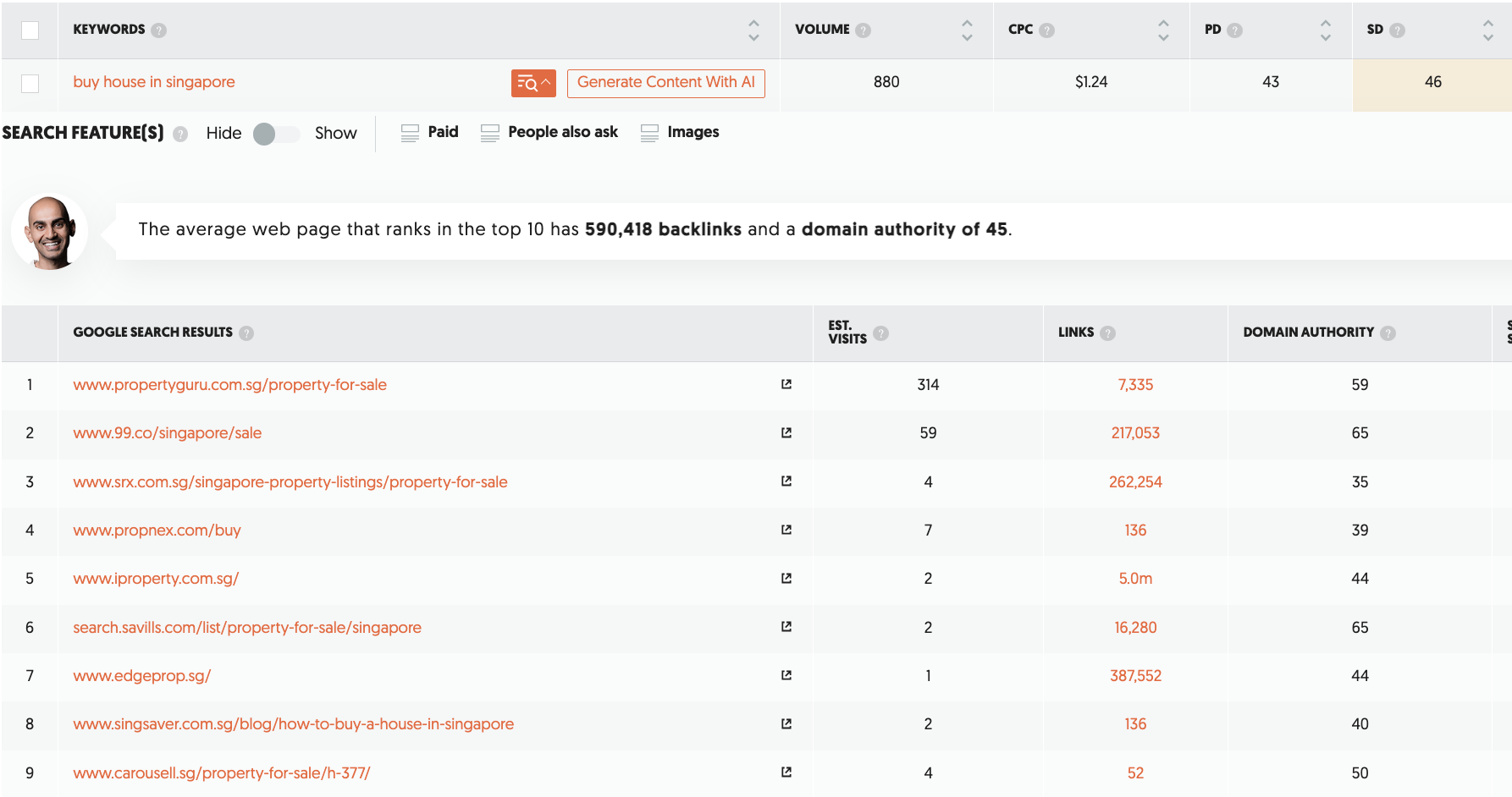
The leading pages aren’t just informative; they’re also the ones with an impressive number of backlinks and high domain authority scores.
Based on SEMrush data, a significant correlation exists between the quantity of backlinks, domain authority, and a website’s ranking position.
The average webpage in the top 10 search results boasts a staggering 590,418 backlinks and a domain authority of 45.
Moreover, the average Domain Authority Score among these top performers is 67.42 out of a possible 100, further underlining the critical role of link equity.
Links are not just digital connections between websites; they are regarded by Google as “votes” of confidence and quality. According to Moz, a staggering 21% of Google’s ranking algorithm relies on “link authority features.”
According to Google’s Andrey Lipattsev, links are one of the three major ranking factors in Google. So if you want your website’s pages to rank high in search, you will almost certainly need links.
Google’s Perspective on Links and Content Quality
Google uses various signals to ascertain the expertise, authoritativeness, and trustworthiness of content.
One crucial factor in this evaluation is whether prominent websites link to or refer to the content in question.
This external validation often indicates that the information is widely trusted. Additionally, aggregated feedback from Google’s Search quality evaluation process is utilised to refine the assessment of content quality.
This is why link building is so important: Google looks at them as an indicator of quality content. The more high-quality links pointing to your site, the higher it will rank in the search results — and ultimately, the more traffic you’ll get.
What makes a good link ?
Embarking on a link building journey requires understanding the components that make up a high-quality link.
In the realm of SEO, there is a myriad of opinions and best practices regarding link building. While the precise workings of Google’s link valuation remain a closely guarded secret, there are widely accepted principles within the SEO community for assessing the value of links.
1. Authority:
When assessing the authority of a link, two critical metrics often come into play: Domain Authority (DA) and Page Authority (PA). Both are predictive measures developed by Moz, designed to estimate how well a website or page will rank on search engine result pages (SERPs).
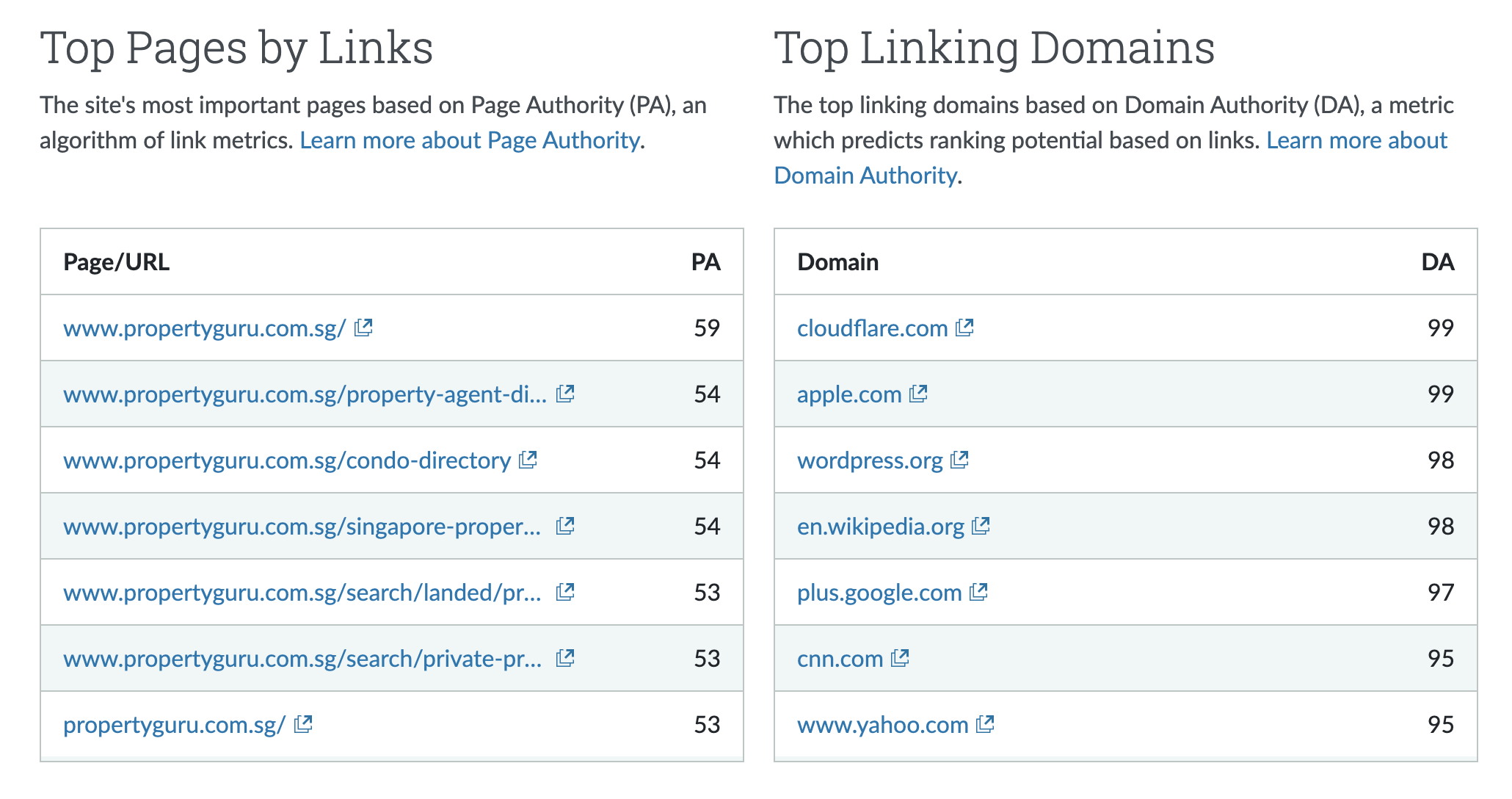
When determining the value of a link, consider both the Domain and Page Authority. A link from a site with high DA and PA, like a trusted news outlet, typically carries more weight than one from a generic business directory.
Incorporating these measures into your link building strategy can help you target high-quality links that will not only boost your site’s authority but also ensure content relevance, aligning with the latest perspectives on SEO best practices.
2. Relevance:
According to insights from a ex Google engineer, the tides have shifted from the historic emphasis on PageRank:
“…getting a link from a high PageRank page used to always be valuable, today it’s more the relevance of the site’s theme in regards to yours, relevance is the new PageRank.”
This statement crystallizes the importance of contextual relevance in link building.
A link must be contextually relevant to carry weight. For instance, a hyperlink on a culinary blog that directs readers to a retailer selling kitchen gadgets is inherently valuable.
This is because the link creates a bridge between two closely related topics, reinforcing the relevance of both the source and the destination content. Conversely, the same link placed on a page about wildlife would not have the same strength or relevance, as the topics are unrelated.
The relevance of the linking site’s theme in relation to your own is now seen as a strong signal to search engines, often more so than the historical value attributed to PageRank.
When a link is contextually appropriate, it not only enriches the user experience but also aligns with Google’s refined approach to assessing the quality and relevance of web content.
3. Placement
The strategic placement of links on a webpage plays a significant role in the value they offer. It’s been understood within the SEO community for some time, and reinforced by discussions on prominent SEO forums like Search Engine Roundtable, that not all links are weighed equally by search engines.
Google’s algorithms are sophisticated enough to discern the placement of a link on a page, attributing different values to links based on where they are found.

Links that are nestled within footers and sidebars are typically less valuable than those that are prominently placed in the main body of a page’s content.

The rationale is straightforward: links in the main body are more likely to be directly related to the content and, therefore, are deemed more useful to readers.
3. Anchor text:
Moving on to anchor text, which is the visible, clickable text in a hyperlink, this element serves as a direct signal to both users and search engines about the content of the link’s destination page.
Google interprets anchor text as a descriptor that helps understand the context and subject matter of the linked page. This is why the choice of anchor text can influence how Google perceives the relevance and topic of a page, impacting its rankings.
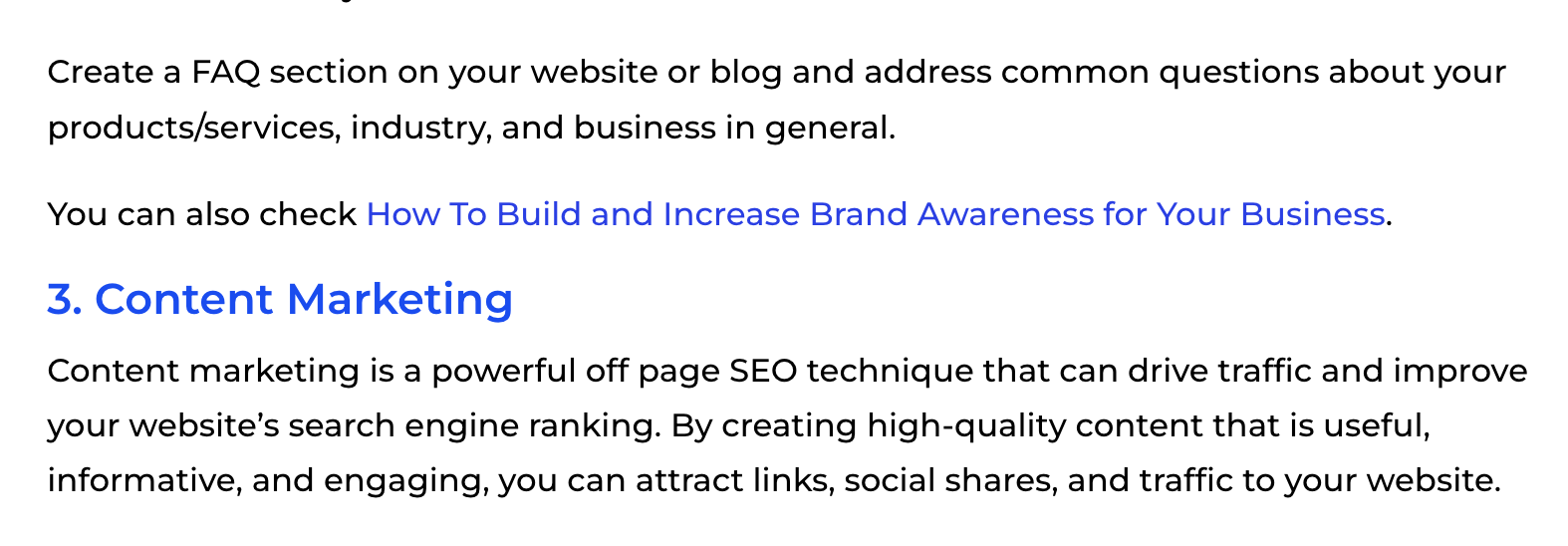
For example, the above anchor text, “how to build and increase brand awareness for your business,” tells Google that the page that follows is about how to increase brand awareness for business.

While generic anchor text like “survey” gives little context and isn’t helpful.
Therefore, when crafting anchor text for links, it’s crucial to use descriptive, relevant words that accurately reflect the content of the page being linked to.
4. Nofollow vs follow:
The differentiation between follow (also known as “dofollow”) and nofollow links has been the subject of much discussion among SEO professionals.
Historically, follow links have been prized for their ability to pass on link equity—value and authority from one site to another.
Nofollow links, conversely, were introduced to signal to search engines that the link should not influence the ranking of the link’s target in the search engine’s index and should not pass along link equity.
Link Building Strategy Step by Step
Discover a step-by-step link building strategy to boost your site’s visibility and authority in the digital landscape.
Step 1: Pursuing competitor’s links
Competitor link research is one of the most fundamental activities in link building. Think about it, the top-ranking page for your desired search query has all the right links which persuaded Google of its superiority.
By studying its links you can figure out which tactics to use so that you can get similar links and outrank that page.
There are many ways to approach your competitors’ links but I hope to show you here how to do it at scale, with some free tools and a little bit of technical know-how
To execute competitor link research effectively, you can leverage tools like Ubersuggest to analyze backlinks at scale. With these tools, you’re able to obtain a comprehensive view of where your competitors are getting their links from.
Example of How to do Pursuing Competitor Links
I have a business in Real Estate Agency, and I want to analyse my competitor and how they get their backlinks. You can use Ubersuggest Backlink Checker. Insert your competitor’s website, and see where they got their backlinks.
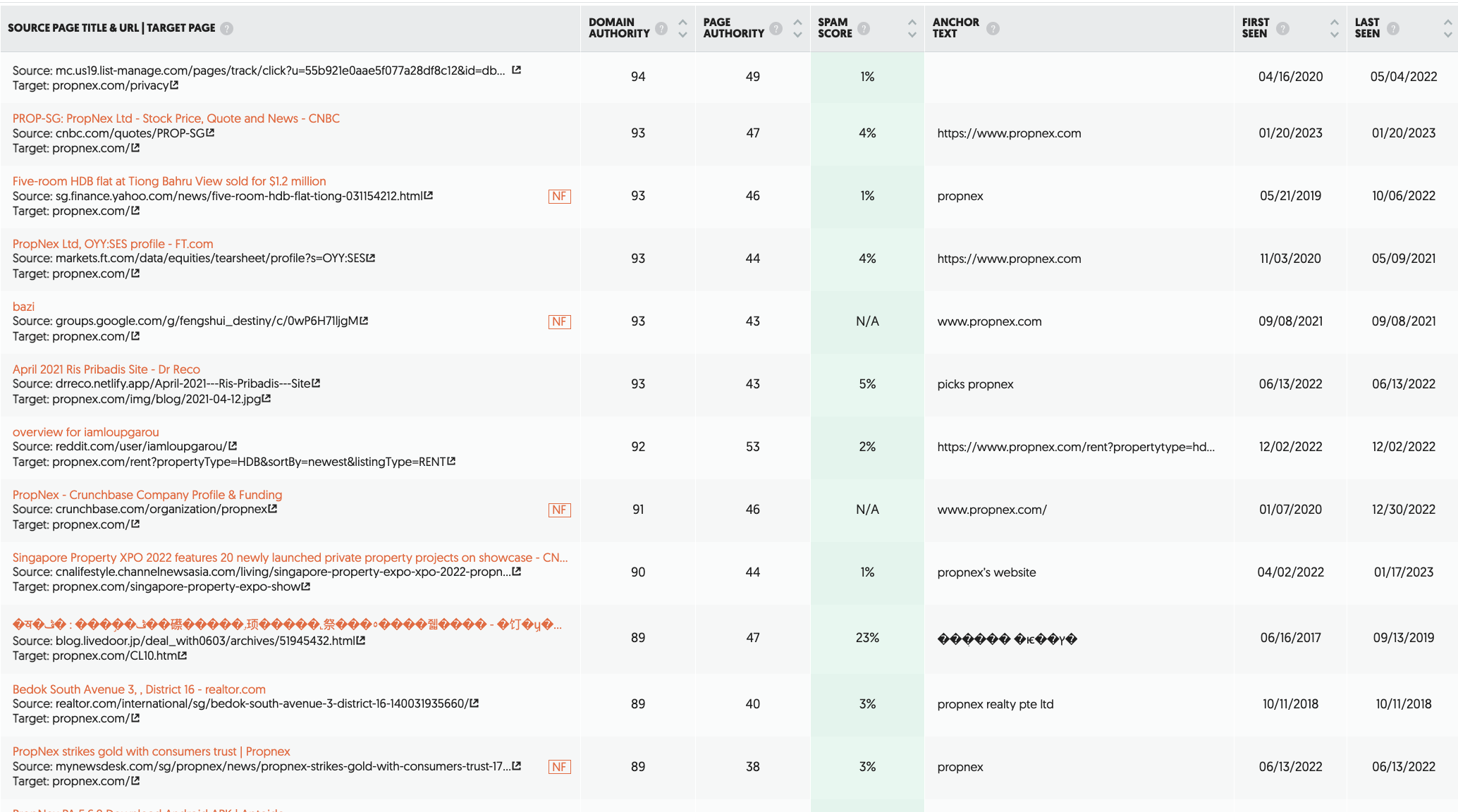
From the image provided, we gain valuable insights into the backlink profile of your competitor, namely PropNex. It reveals a variety of sources from which PropNex has secured backlinks, which can inform your own strategy for link building.
Notably, the presence of a backlink from Crunchbase.com suggests that PropNex has established a company profile there. Emulating this, you could create a profile on Crunchbase for your business, ensuring that all your company information is thorough and current, potentially leading to a valuable backlink.
Likewise, their listings on property platforms like realtor.com indicate that PropNex has utilised industry-specific directories to obtain backlinks. If your enterprise operates within the same sector, it would be advantageous to secure listings on comparable platforms.
Additionally, a backlink from a press distribution site such as mynewsdesk.com implies that PropNex may be involved in public relations or content distribution endeavours leading to backlinks. This observation could encourage you to engage in similar strategies for content distribution or press releases to earn backlinks from news outlets or industry-focused portals.
Step 2: Identifying Listing Directories
Embarking on the second step of your link building strategy involves leveraging listing directories, a critical resource for securing valuable backlinks. Start by conducting searches for industry-specific rankings, such as ‘Top Real Estate Agencies in Singapore’. This will guide you to directories and platforms that feature and promote businesses within your sector.
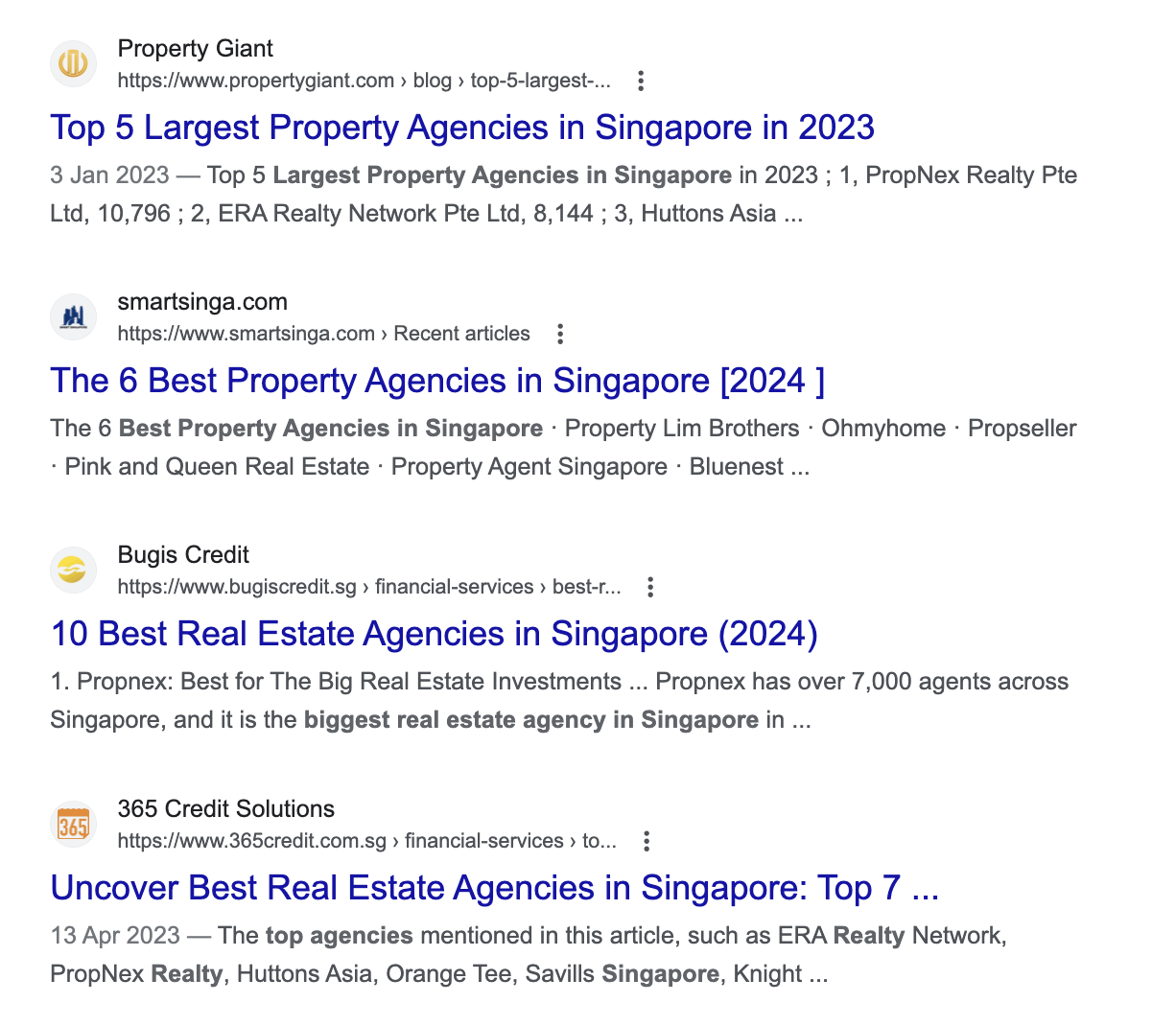
Upon identifying potential directories like Property Giant, SmartSinga, Bugis Credit, and 365 Credit Solutions, the next action is to methodically list these websites. This list will become the cornerstone of your endeavour to feature your business within these directories, thus ensuring visibility among those seeking the industry’s top contenders.
The compilation of such a list sets the stage for a targeted outreach campaign. By proactively reaching out, you can secure a listing that not only amplifies your online presence but also aligns your brand with the industry’s best, directly in front of an engaged and relevant audience.
After crafting your comprehensive list, the forthcoming step is to devise and implement an outreach strategy. This will involve contacting these directories to secure a spot for your business, a process that we will delve into next, ensuring your link building efforts are systematic and effective.
3. Outreach Email
Step 3 of your link building strategy is centred around outreach. This is where you take the list of directory websites you’ve compiled and begin the process of actively requesting a backlink.
Crafting a compelling outreach email is crucial, as it serves as your initial point of contact and sets the tone for your interaction.
Here are detailed components of a successful outreach email strategy:
- Personalization: Start by personalizing each email. Use the recipient’s name and reference specific details about their website or directory to demonstrate that you’ve done your research.
- Introduction: Briefly introduce yourself and your business. Establish credibility by mentioning any common connections, shared interests, or how you found their directory.
- Value Proposition: Clearly articulate the value that adding your business to their directory would bring. This could be the unique aspects of your services, the quality of your listings, or the additional choice you provide to their audience.
- Request: Make a direct but polite request for inclusion in their directory. Be specific about what you’re asking for, such as a backlink, a feature, or a mention.
- Incentive: Where appropriate, offer something in return. This could be content contributions, a reciprocal feature, or exposure to your audience.
- Call to Action: End with a clear call to action. This could be a request for a reply, a follow-up meeting, or directing them to a form to list your business.
- Closing: Thank them for their time and consideration, and include your contact details for further communication.
You can use ChatGPT to help you create an email outreach, for example from the listing we can see that one of the website is https://www.propertygiant.com/blog/top-5-largest-property-agencies-in-singapore-in-2023. Then we can use this prompt.
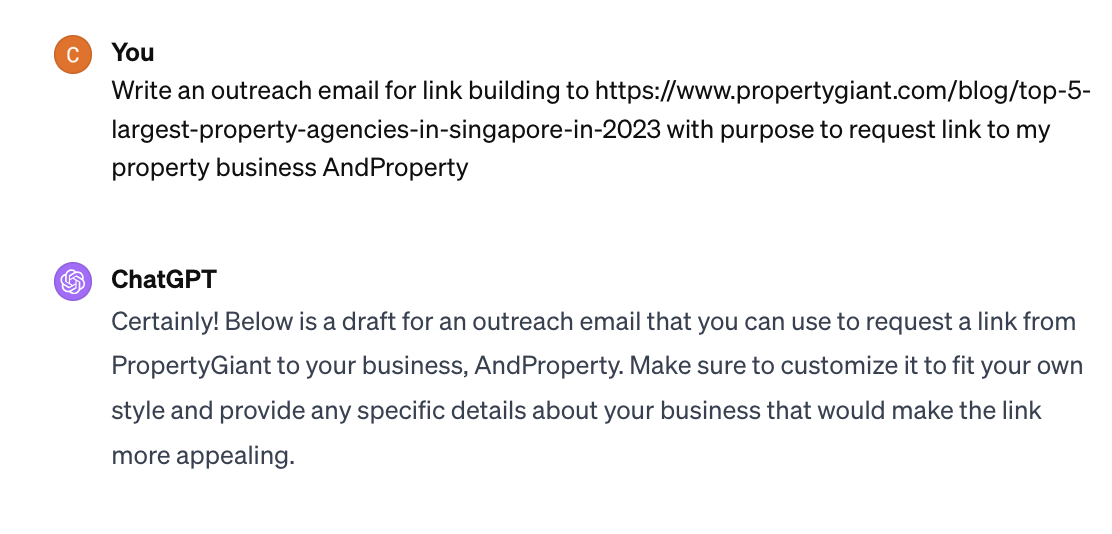
Email Outreach Template
Subject: Potential Collaboration Opportunity with [your business]
Dear [Recipient’s Name],
I hope this message finds you well. My name is [Your Name], and I am reaching out on behalf of [business name], a dynamic and innovative property business.
I recently came across your article, [link of article] on [website name], and I must commend the insightful and comprehensive analysis you have provided. It is clear that your platform is a valuable resource for anyone interested in the property sector in Singapore.
Given the synergy between our businesses, I am writing to propose a collaboration opportunity. Our business, [business name], offers [briefly describe what your business offers and its unique value proposition]. I believe a mention or a link to our website on your platform, particularly in your aforementioned article, would greatly benefit your readers by providing them additional resources.
In return, we are more than happy to feature [website directory] on our platform or explore other mutually beneficial collaboration opportunities. We are committed to building a relationship that is advantageous for both parties.
I would love to discuss this further with you at your earliest convenience. Please let me know if you are interested in this collaboration or if you have any other ideas in mind.
Thank you for considering this proposal. I look forward to the possibility of working together.
Warm regards,
[Your Name]
[Your Position]
AndProperty
[Contact Information]
4. Create High Quality Content
Step 4 in your link building strategy focuses on creating high-quality content, an indispensable aspect of attracting and earning backlinks. This step hinges on the principle that exceptional content naturally invites other websites to link to it, thus enhancing your link building campaign.
Here’s how to approach this step:
- Research and Relevance: Begin by researching topics that resonate with your audience and align with your industry expertise. This ensures that the content you create is both relevant and valuable.
- Content Planning: Develop a content calendar that outlines what types of content you’ll create. This could include blog posts, in-depth guides, infographics, or videos.
- Quality and Originality: Focus on producing content that is not only informative but also original. It should offer unique insights or data that can’t be found elsewhere.
- SEO Best Practices: Optimize your content for search engines using keywords, meta tags, and structured data. However, remember that user experience is paramount, so keep the content engaging and reader-friendly.
- Promotion and Distribution: Once your content is published, actively promote it through social media, email newsletters, and other channels to increase its visibility.
- Engagement: Encourage engagement with your content by enabling comments, asking questions, and participating in community discussions. This increases the likelihood of sharing and linking.
- Monitoring and Updating: Keep track of how your content performs and be ready to update it with fresh information to maintain its relevance and usefulness over time.
High-quality content is the cornerstone of effective link building, as it serves as a magnet for backlinks and boosts your site’s authority and value in the eyes of both users and search engines.
5. Follow Up Strategy
Your initial outreach is only the beginning. Following up is critical to keeping your requests on the radar of directory owners and webmasters.
A well-timed follow-up email can often be the nudge that prompts a busy site owner to take action on your previous request. However, it’s essential to strike a balance between being persistent and being pushy. A couple of follow-up emails spaced out over a few weeks are generally acceptable.
If there’s no response after two or three attempts, it’s prudent to respect their silence and channel your energies into identifying new directories for potential backlinks.
Others Link Building Strategy
In addition to the structured steps we’ve explored for link building, there are other dynamic strategies that can complement and amplify your efforts. These strategies can diversify your backlink profile and enhance your online authority.
1. Creating linkable assets

Creating linkable assets stands as a pivotal component of a robust link building strategy. These assets are essentially high-quality, valuable pieces of content that magnetize backlinks from various websites due to their utility or appeal.
When we delve into the realm of linkable assets, several formats spring to mind that are traditionally recognised for their link-attracting potential:
- Infographics: Visually engaging and informative, they distil complex data into digestible visuals.
- Tools: Online resources or calculators that provide utility or solve problems for users.
- Whitepapers/Reports/Ebooks: In-depth content that offers valuable insights or comprehensive information.
- Videos: Multimedia content that can range from educational to entertaining, resonating with a broad audience.
- Competitions: Engage users with the chance to win something, prompting them to share and link to your content.
- Interactive Content: Quizzes, surveys, or any content that involves user interaction and offers personalised results or data.
This list, while not exhaustive, encompasses some of the more prevalent forms of content known to generate backlinks. In essence, a linkable asset could be any piece of content that someone finds beneficial enough to share and link back to.
The underlying principle for creating linkable assets is to forge content that stands out for its invaluable utility or captivating nature, compelling other site owners to link to it as a resource for their own audience.
Whether it’s a well-researched paper, an entertaining video, or a handy tool, if it delivers significant value, it has the potential to become a linkable asset.
2. Engaging with Communities

Engaging with online communities presents a unique opportunity for link building by promoting your content to targeted, interested audiences.
Whether you’re in real estate, tech, or any other industry, you’re likely to find a dedicated group of like-minded individuals on platforms like Reddit, Facebook, Slack, or Discord, as well as on niche-specific community sites.
However, successfully leveraging these communities for link building requires a tactful approach:
1. Integrate Into the Community
Before you consider sharing any content, it’s essential to embed yourself within the community. This involves regular interaction, such as participating in discussions, offering insights, and assisting others.
Establishing yourself as a trusted and helpful member not only gains you respect but also provides insight into the types of content the community values.
2. Contribute Valuable Content
As an active community participant, you’ll find numerous opportunities to contribute. When you do share information or advice, ensure it’s valuable and enriches the ongoing conversation.
This is the point where sharing your content can be natural, especially when it directly relates to the discussion at hand.
3. Strategic Content Sharing
The effectiveness of your content sharing is heavily influenced by timing. Communities often have peak activity times that differ from those of brand pages.
To maximise engagement with your posts, it’s crucial to determine the optimal times for activity within each specific community. This may require a bit of experimentation, but understanding the rhythms of the group will ensure your contributions are seen and appreciated.
By becoming a respected community member and sharing content that adds value, you can cultivate an environment where linking to your resources is welcomed and beneficial for all parties involved. This strategic community engagement can lead to natural, high-quality backlinks that boost your SEO efforts.
3. Guest Blogging

Guest blogging is the practice of contributing a post to another person’s blog in order to build relationships, exposure, authority, and links. You’re writing for someone else’s site but you usually get an author byline (your name and a link to your site).
Unfortunately, not every blog owner is open to accepting guest posts. Some are worried about the quality of the content. Others have had bad experiences with guest bloggers promoting their own products or trying to use the post for SEO purposes (to build links to their site).
But whatever the reason, these blog owners are always looking for interesting and high-quality content that adds value to their audience. And if you can deliver on that, there’s a good chance they’ll accept your guest post.
So, here are two tips that should help increase your chances of getting published:
1. Customize your pitch for the blog you’re contacting
The problem with many guest post requests is that they look like form letters sent out in mass. If you want the blog owner to take your request seriously, it needs to appear as though you actually did some research on the site and its audience.
That means addressing them by name and mentioning a few posts of theirs that resonated with you. This will show them that you took time to learn about their site and
2. Have a great idea
You can only make a first impression once, so don’t waste it on an uninteresting topic or one that has already been covered many times before.
The fact is, there are plenty of websites out there right now that are struggling to gain readership because they don’t have much unique content on them. Don’t let yours be one of them. Make sure whatever topic you choose is likely to pique the interest of the blog’s readership.
4. Utilising Connectively (New Version of HARO)
Connectively, the new version of HARO, connects writers with experts. By sharing your insights, you can secure valuable backlinks from top-tier news sites and blogs. Fast, consistent responses enhance your chances of being featured.
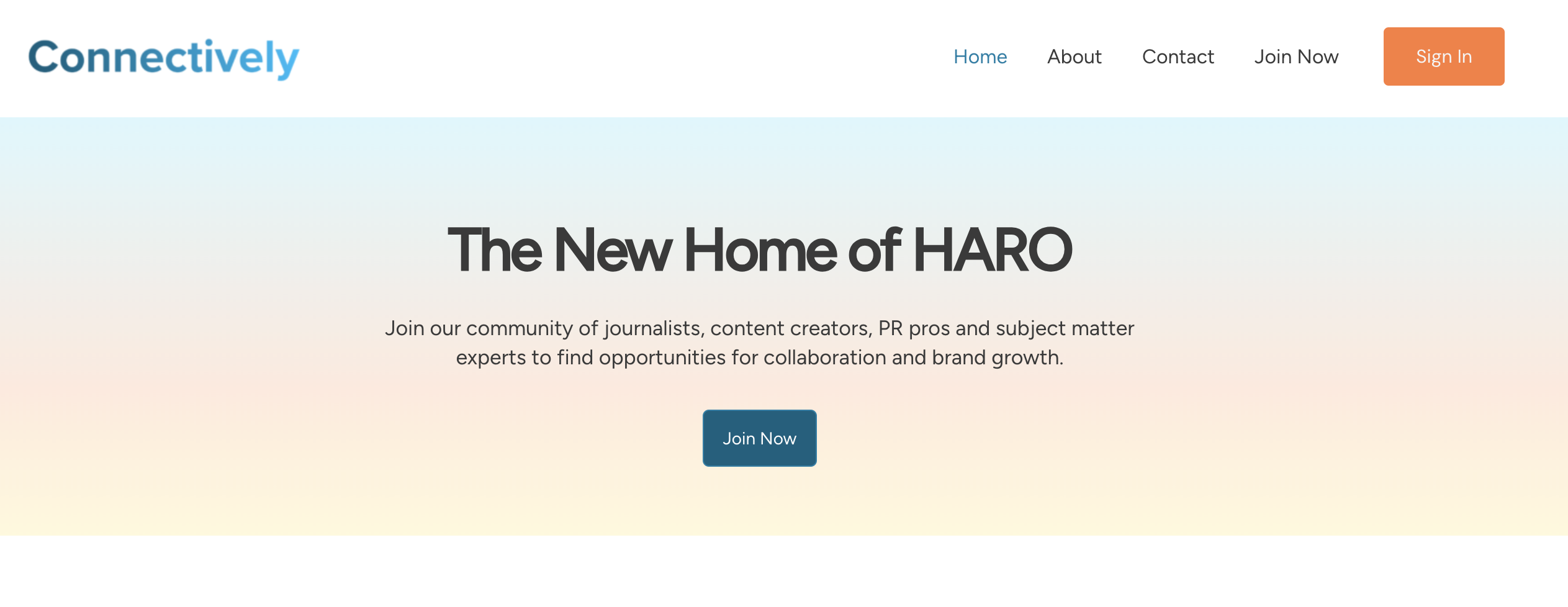
Connectively bridges the gap between those seeking sources (writers) and those seeking exposure (you). Receive daily emails listing writers and businesses in need of expert input.

Even major media outlets utilize such services. In 2024, HARO is transitioning to Connectively. Sign up and position yourself as a Subject Matter Expert to thrive in digital marketing’s ever-evolving landscape.
Let’s Wrap this up
In the grand scheme of SEO, link building is not an arcane science; it’s an exercise in diligence, strategy, and persistence. With the right approach and resources, anyone can excel at it.
Should you find yourself in need of expert assistance, a list of reputable SEO agencies, including Neu Entity’s own SEO Services, can be found at SEO Agencies in Singapore and Neu Entity SEO Services.
Equipped with this guide’s insights and techniques, you’re now ready to take on the challenge. So go forth with confidence and start forging those valuable links!
Related Articles
Let’s Talk!
If what you see here is relevant for you and can help you grow your business or organisation, we’d love to discuss further with you. Drop us a message or schedule an appointment with us.



